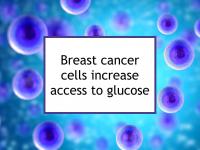High circulating blood sugar (hyperglycemia) and insulin (hyperinsulinemia) both have been found to increase breast cancer risk and reduce survival. Some studies have reported that the use of insulin to treat type 2 diabetes is associated with higher risk of breast cancer mortality whereas others have found no such association.
This can present a dilemma for those who require insulin to control their blood sugar. On the one hand, breast cancer patients and survivors recognize the need to control blood sugar in order to deprive breast cancer cells of a ready source of glucose. On the other hand, injecting insulin could potentially deliver another compound to tumor cells that stimulates their growth.
Now a new study has reported a mechanism by which breast cancer cells suppress the production of insulin by the pancreas, thereby resulting in impairment of blood sugar control. In other words, breast cancer cells can act directly to increase their supply of glucose and they appear to have a preference for high blood sugar rather than high circulating insulin. In the study, the authors conducted animal experiments which showed that good sugar control using insulin produced favorable results. This suggests that those with breast cancer can safely use insulin in a deliberate manner to keep blood sugar in a fairly tight range. Meals or snacks that result in temporary but significant increases in blood sugar should be avoided.
Latest research finds breast cancer cells suppress insulin production
In the study, the authors demonstrated that breast cancer-derived extracellular vesicles suppressed pancreatic insulin secretion, thereby harming glucose homeostasis. This may be a partial explanation for the higher blood glucose levels observed in breast cancer patients compared to those without cancer. Extracellular vesicles are hollow spheres secreted or shed by cells. They play an important role in intercellular communication, transporting DNA, RNA, proteins, fats and other materials between cells.
Breast cancer extracellular vesicles were found to contain microRNA-122 that had been secreted by the tumor cells. Upon reaching the pancreas, the vesicles were able to enter insulin producing cells, deliver miR-122, and interfere with the islets' role in maintaining a normal blood glucose level.
In experiments using mouse models of breast cancer, the authors demonstrated that using slow-releasing insulin pellets or an SGLT2 inhibitor (a type of glucose-lowering drug) restored normal control of glucose in animals with mammary tumors. This, in turn, reduced tumor growth. The authors conclude that extracellular vesicle-mediated impairment of glycemic control might contribute to tumor progression and newly diagnosed type 2 diabetes in some breast cancer patients.
Please see our article on type 2 diabetes for more information.
